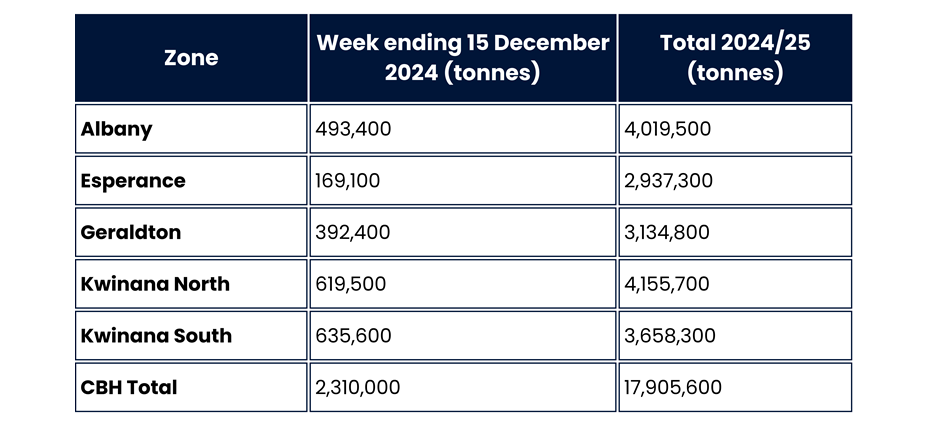Harvest Report - 16 December
Total harvest receivals have now surpassed CBH's estimates for the 2024/25 season, with just under 18 million tonnes now in the system.
In the lead up to harvest CBH expected that the network would receive about 17.5 million tonnes, based on grower estimates provided. As it stands CBH has currently received 17.9 million tonnes across the network - and still going.
All zones except the Esperance Zone have surpassed CBH's estimated tonnes for this years harvest, with only 40,000 tonnes more needed for Esperance to beat its estimate.
The Grains Industry Association of Western Australia (GIWA) also recently increased its crop forecast, which now sits at 19.8 million tonnes for the state.
GIWA attributes the high yields for this year's harvest to a variety of factors which lead to less stress on crops, including the timing and intensity of rainfall; little waterlogging (apart from Geraldton Zone); few cold temperatures in winter; low disease; and low weed competition levels.
The pace of harvest has slowed across most zones, reflecting that many growers are coming to the end of their programs, despite having to switch to-and-from commodities (such as canola and barley) due to wet weather.
CBH Chief Operations Officer Mick Daw said it is the innovative practices of Western Australian growers - in conjunction with positive seasonal conditions - that has led to three of the last four harvests being above average.
"Growers have done an amazing job delivering a crop this size on the back of the season we have had," Mr Daw said.
"It's hard to believe that at the start of the year many parts of the state were facing some of the driest conditions they had experienced for decades. Fast forward six months and to be looking at the third largest crop in Western Australia's history is remarkable.
"Western Australian growers are innovative and resourceful, and by continuously improving their on-farm practices, they are able to adapt and make the most of the environmental and economic circumstances that come their way.
"Quality issues caused by late weather events has been a frustrating development which takes some of the shine off, but it is a significant achievement nonetheless for the WA grains industry and one growers should be immensely proud of."
Receival Statistics

Zone Summaries
Albany
- The Albany Zone has received 4 million tonnes so far, with approximately 493,400 tonnes received over the past seven days. Rain events have slowed down receivals in some areas.
- Wheat and barley are the main commodities being received. Smaller tonnages of canola are still being received in the southern areas of the zone.
- As sites are filling up, some segregations are closing, and growers will have to travel to other sites to deliver some services such as oats.
- Average zone cycle time is sitting at 39 minutes.
Esperance
- The Esperance Zone has received 2.9 million tonnes for the year, with 169,100 tonnes coming into the system in the past seven days.
- Rain slowed down the pace of harvest at the end of the week, however most growers are wrapping up harvest anyway.
- Salmon Gums and Dunn Rock are now closed for the season, with others to follow in the new year.
- Wheat is the main commodity being received now, with very small parcels of canola and barley coming in.Average zone cycle time is sitting at 47 minutes.
Geraldton
- The Geraldton Zone has received 3.1 million tonnes so far this season which is above the estimate for the zone.
- Tonnes have slowed down in the northern part of the zone as farmers finish up for the season.
- Wet weather over Wednesday and Thursday has impacted Areas 2 and 3.
- Wheat is now the major commodity being delivered into the system, however we are still seeing small amounts of lupins, canola and barley.
- All sites and services are open across the zone.
- The Yuna and Binnu sites will close early this week, and hours at Narngulu, Moonyoonooka and Geraldton Grain Terminal will all scale back to a single shift as of Wednesday 18 December.
Kwinana North
- The Kwinana South Zone has received 4.1 million tonnes year-to-date with 619,000 tonnes coming in in the last seven days.
- The zone experienced more rain events during the week, slowing receivals at some sites.
- Wheat is now the major commodity being delivered into the system.
- All sites and services are open across the zone, some sites will close today for the season as harvest finishes in some areas.
- McLevie broke its daily site record again on Thursday 12 December with 9,824 tonnes received, beat the previous week’s record of 9,817 tonnes.
Kwinana South
- The Kwinana South Zone has received 3.6 million tonnes, with approximately 635,000 tonnes received over the past seven days.
- A few rain events near Corrigin and surrounds have only slightly slowed harvest pace.
- Wheat and barley accounts for most of our receivals, with small volumes of oats and lupins also coming in. Most growers are now done with their canola, and most canola segregations have been suspended or closed.
- Tammin (Area 10) is now closed for the season. Dale (Area 12) has also filled and closed, but there are plans to re-open the site next week. All other sites are still open as normal.
- Cycle times have slowed down across most sites, with the zone average now sitting at 38.7 minutes.
- Brookton broke its daily receival record on Wednesday 11 December with 13,783 tonnes received. Dale also broke its daily receival record on Monday 9 December with 3,290 tonnes received, beating the previous week's record.
